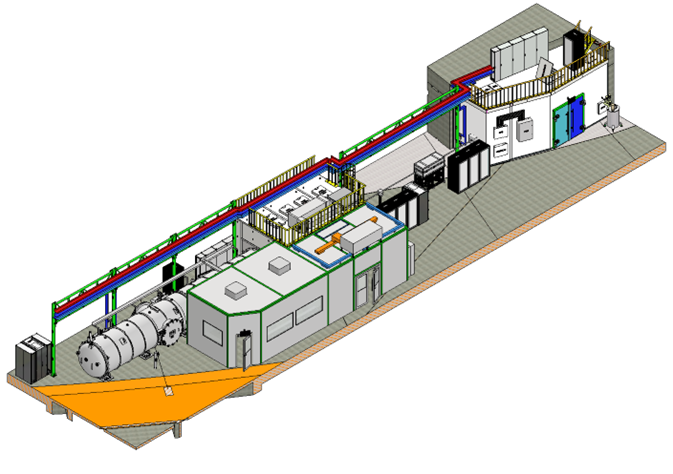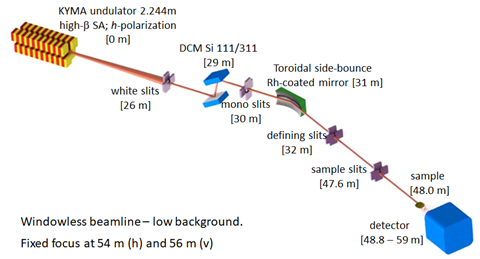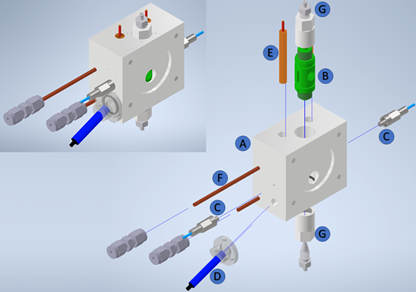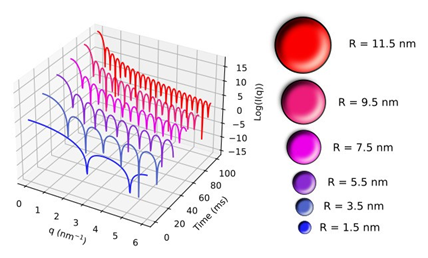CONTACT & STAFF
Facility E-mail: sapucaia@lnls.br
Coordination: Leandro R. S. Barbosa
Tel.:
E-mail: leandro.barbosa@lnls.br
Click here for more information on this Facility team.
SAPUCAIA (Scattering APparatUs for Complex Applications and In-situ Assays) will be a beamline dedicated to Small-Angle X-ray Scattering technique (SAXS). SAXS is a structural characterization technique used to study the morphological (shape, size, and spatial organization) and dynamical properties of nano- and micro-structured objects. It is a well-established technique, having application in a wide variety of research fields such as in physics, chemistry, biology, and engineering. The beamline will permit to answer many questions concerning life science (biological and medical applications), structural biology (proteins, nucleic acids, lipids, and general macromolecules) and in a vast field of material science, including nanotechnology, polymers, rheology and environmental sciences.
SAPUCAIA was idealized and designed to have a high performance (with high reproducibility of the experiments), in addition to its easy use and change of the experimental setup whenever the user wishes. It will host a tunnel of about 15 m long, with 2 m in diameter. Inside the tunnel (always kept under low pressure) there will be a support containing the detection system. The system can move along rails, allowing the users to have access to different experimental conditions while carrying out their experiments. The definition of the beamline design was based on three main characteristics that will make SAPUCAIA one of the most important beamlines worldwide, which are: low parasitic scattering, low beam divergence and high stability of the optical components. These features allow for the study of particles from dimensions of a few nanometers to micrometers, so SAPUCAIA will be a versatile tool for researchers of very distinct and diverse study areas.

SAPUCAIA Beamline representation
Facility E-mail: sapucaia@lnls.br
Coordination: Leandro R. S. Barbosa
Tel.:
E-mail: leandro.barbosa@lnls.br
Click here for more information on this Facility team.

General overview of the optical elements in the SAPUCAIA beamline.
| Elements | Type | Position [m] | Description |
|---|---|---|---|
| SOURCE | Undulator | 0 | 2x 1.122 m long KYMA undulators, horizontal polarization, high beta straight section |
| S1 | White slit | 26 | Slit placed on the optical hutch entrance |
| DCM | Monochromator | 29 | Two-crystals vertical-bounced monochromator (Si 111 or Si 311) |
| M1 | Mirror | 31 | Horizontal-bounced Rh toroidal mirror (Meridional radius: 97 mm; Sagittal radius: 7800 m) |
| S2 | Defining slits | 32 | Beam defined slits |
| S3 | Sample slits | 47.5 | Scatterless slits placed in front of sample position |
| SH | Sample-holder | 47.8 | Sample-holder position |
| TN | Tunnel | 48 – 62 | Vacuum tunnel with detector wagon |
| DET | Detector | 48.5 – 58.5 | PiMega Detector |
| Parameter | Value | Condition |
|---|---|---|
| Energy range (keV) | 6 – 17 | Optimized to work using 10 keV |
| Beam size (μm2) | 250 x 220 (h x v) | On sample position. Estimative based on simulations (Shadow) |
| Beam divergence (μrad2) | 21 x 19 (fonte, h x v) 29 x 23 (amostra, h x v) |
Estimative based on simulations (Shadow) |
| Photon flux (photons/s/100mA) |
1.5 x 1013 (@6 keV) 0.5 x 1013 (@10 keV) 0.1 x 1013 (@17 keV) |
On sample position. Estimative based on simulations (Shadow) |
| Energy Resolution (λ/Δλ) | 30000 (Si 311) 7500 (Si 111) |
Estimative for 10 keV based on optical parameters and beamline divergence |
| Polarization | Horizontal | KYMA Undulators |
| Q min – max (nm-1) | 0.019 – 6.0 (@6 keV) 0.032 – 10.0 (@10 keV) 0.054 – 16.9 (@17 keV) |
Detector close to sample (0.8 m) |
| Q min – max (nm-1) | 0.0014 – 0.45 (@6 keV) 0.0023 – 0.75 (@10 keV) 0.0040 – 1.3 (@17 keV) |
Detector far from sample (10.8 m) |
| Q max (WAXS) (nm-1) | 13.9 (@6 keV) 23.2 (@10 keV) 39.5 (@17 keV) |
Detector inside tunnel, 0.8 m from sample |
SAPUCAIA will have an experimental station with capability to perform different variations of SAXS experiments along with complementary analytical techniques in situ. There will also be an automatic sample changer robot for liquid samples. Other than conventional SAXS, users will be able to perform Wide-Angle X-ray Scattering (WAXS), Time-Resolved SAXS (TR-SAXS) to track sample changes in millisecond timescale, Anomalous SAXS (ASAXS) for certain types of samples and couple Size Exclusion Chromatography with SAXS inline (SEC-SAXS) for sample substrate selection, such as different protein oligomeric states. Different sample handling methods, such as stopped-flow,and microfluidics will also be available for users.
The sample holder for liquids will consist in a 1.5 mm capillary enclosed by a heater/cooler device which controls the temperature in the range of 10 to 80°C. It will have close to 30° of exit angle and will be monitored by an optical camera which will give information such as the position of the meniscus, capillary cleanse, and inconvenient presence of bubbles. A 180° opening will hold an UV-Vis spectrophotometer equipment to monitor solution’s concentration. As it is very important to obtain accurately the temperature of the capillary, it will be measured using an IR thermal 2D camera and, indirectly, thermocouples. The sample holder permits the ease change of the capillary holder in case it breaks or becomes inappropriate to be used, but keeping all other facilities untouched. It will be attached to vacuum pipes and, despite the capillary, there are no other X-ray windows.

Exploded-view of the liquid sample holder, which contains temperature control by resistors and water flow as coolant and will also allow simultaneous UV-Vis spectroscopy measurements. (A) Sample holder outer structure; (B) Capillary holder; (C) UV-Vis spectrophotometer; (D) Visible light camera; (E) Cartridge resistances; (F) Water pipes; (G) Capillary-holder cradles.
The high photon flux provided at SAPUCAIA will allow the user to perform experiments in shorter timescales than most X-ray sources, with similar signal-to-noise ratio. This feature brings the possibility to study phenomena with faster dynamics, such as protein folding and unfolding, nanoparticle formation and protein-ligand interactions.

Time-Resolved SAXS data simulated for spheres with increasing radii over time. According to our simulations, we will be able to perform units of milli-second SAXS Patterns.
A widespread problem in SAXS experiments is having samples with different aggregation states, which may be an issue for data analysis, especially for unstable proteins. By coupling Size Exclusion Chromatography (SEC) columns to the sample holder, it’s possible to separate scatters of assorted sizes, such as different oligomeric states of a protein, to study each set individually and overcome issues related to sample polydispersity.
Anomalous SAXS (ASAXS) uses the deviations on the scattering properties of selected atoms when the energy of the incident X-rays is close to the binding energy of the most-inner electrons to the atoms. In this technique, measurements are performed in several X-ray energies near the absorption edge for an element of interest, which is analogous to measuring a same particle varying the electron density for that element. This brings information regarding the behavior of the element of interest apart from others in the sample.
Thus, such a procedure allows one to obtain element-specific information on the sample. Such measurement is quite common and applied in condensed matter or inorganic systems, where the binding energies of the electrons are in the range of few keV.
Recently, however, there were some studies in the literature in which such phenomena were observed for biological systems, like proteins*. At SAPUCAIA, users will be able to change the X-ray energy from 6 up to 17 keV, in order to perform anomalous SAXS experiments.
* Gruzinov, Andrey Yu, et al. “Anomalous SAXS at P12 beamline EMBL Hamburg: instrumentation and applications.” Journal of synchrotron radiation 28.3 (2021).
SAXS is a versatile technique regarding sample preparation requirements and a variety of sample holders will be available for users. Nevertheless, there are optimal sample conditions for SAXS depending on the system studied. SAPUCAIA Sapucaia will host both liquid-like, gel-like and solid-like samples, being all of them set at controlled temperature. Nevertheless, we recommend contacting the beamline staff for more information regarding sample concentration and temperature ranges, among other features.
It is fundamental to study the structure pf proteins and protein complexes, to have insight on how they work biologically. SAXS allows the user to obtain valuable information regarding proteins’ size, mass, folding state, and shape in solution under a wide range of conditions.
At SAPUCAIA, users will benefit from high signal-to-noise ratio due to high flux and low parasitic scattering as compared to other X-ray sources, which allows not only collecting data for more dilute samples but also performing time-resolved experiments to follow dynamic processes in the millisecond timescales. The beamline will also provide means of performing chromatographic processes inline and in sito followed by SAXS measurements, allowing the study of different oligomeric states and mitigation of issues related to protein aggregation.
Nanoparticles are of special interest for different scientific fields, ranging from personalized medicine to food and agricultural industry, being used also for removing environmental contaminants like heavy metals and inorganic and organic pollutants.
SAXS is a particularly interesting technique for studying this kind of system not only due to the information that it allows the user to achieve, but also on the wide range of conditions that experiments can be performed.
At SAPUCAIA users will be able to perform experiments to follow nanoparticle formation, the effect of drug (or other molecule of interest) encapsulation or release on the nanoparticle structure, phase transitions in short timescales and for a broad range of particle sizes, allowing not only the retrieval of local information but also on overall size nanoparticle distributions. Furthermore, the small divergence of Sapucaia, along with its undulator source, allow measurements of scattering particles as large as 2 – 4 mm, allowing the users to study small micrometer particles.
The study of polymers is present in several different scientific areas, and they are used for a large spectrum of applications, from cosmetics to fuels, and polymer samples can be studied by many different experimental techniques, from rheology to spectroscopy, which can benefit from the complementary information provided by SAXS. Here in SAPUCAIA the user will benefit from beamline features such as small timescale between measurements to follow size and structure of fast polymerization and crosslinking processes, and the especially low scattering angles achieved due to our tunnel length will also allow the study of large polymeric complexes and phase transitions.
Following catalytic processes is of great interest in a broad range of areas, from fundamental biological processes to industrial applications. At SAPUCAIA beamline, the user will be able to study catalysis in both liquid or solid media at short timescales and stopped-flow devices will also be available for studying catalysis dynamics from earlier steps in the process. This will allow the users to follow catalysis in more detail for diverse conditions and catalysts.